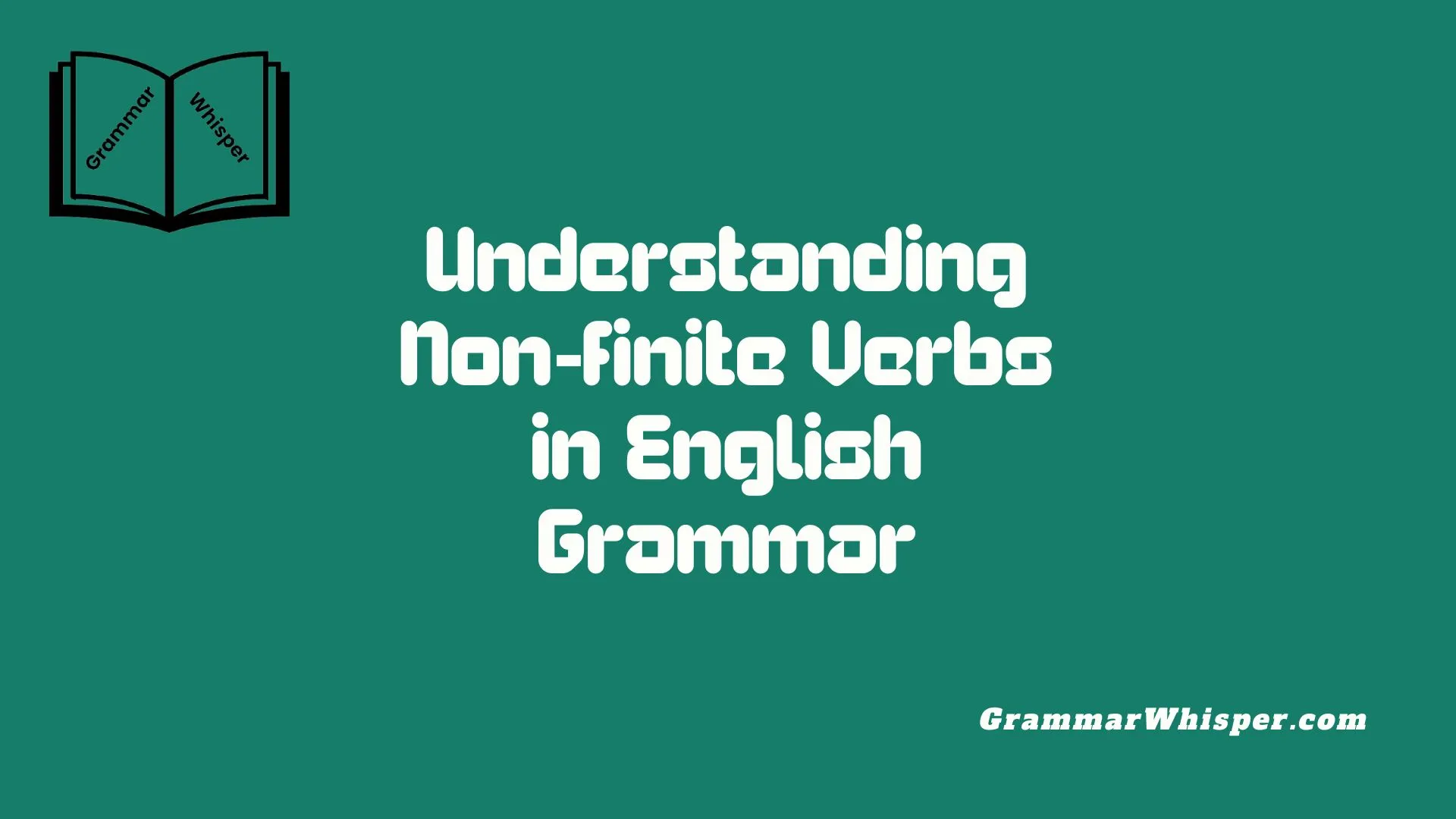When I first taught English grammar, I noticed my students struggled to see the difference between finite verbs and Non-finite Verbs. Finite verbs shift based on tense, person, or number, while non-finite verbs remain constant. They don’t reflect time, nor can they serve as the main verb in a sentence. What makes them so useful is their ability to act as nouns, adjectives, or adverbs, injecting depth and flexibility into the language.
Take writing as an example. In the sentence “Writing daily improves your skills,” the word functions as a subject, not just a verb. This ability to multitask is why non-finite verbs are so essential. They let you express more with fewer words, creating a more natural expression. Once students grasp this, their command of English becomes noticeably sharper.
What Are Non-finite Verbs?
Non-finite verbs are verb forms that do not show tense, person, or number. They include:
- Infinitives: to write, to read
- Gerunds: writing, reading
- Participles: written, reading
These forms are crucial in constructing sentences that convey actions or states without anchoring them to a specific time frame.
How Non-finite Verbs Function in Sentences
Non-finite verbs serve various roles:
- As nouns: Swimming is fun.
- As adjectives: The broken vase was expensive.
- As adverbs: He left to catch the bus.
They often appear in subordinate clauses or phrases, providing additional information without serving as the main verb.
The 3 Types of Non-finite Verbs: A Practical Overview
| Type | Form | Function | Example |
| Gerund | Verb + -ing | Noun | Swimming is enjoyable. |
| Participle | Verb + -ing/-ed | Adjective/Adverb | The broken window needs repair. |
| Infinitive | To + base verb | Noun/Adj/Adv | She wants to learn Spanish. |
Gerunds: Verbs Acting as Nouns
What is a Gerund?
A gerund is the -ing form of a verb that functions as a noun. It can act as a subject, object, or complement in a sentence.
Examples:
- Subject: Running is healthy.
- Object: I enjoy reading.
- Complement: His hobby is painting.
Recognizing and Using Gerunds
Gerunds can be part of gerund phrases, which include the gerund and its modifiers or objects.
Example:
- Swimming in the ocean relaxes me.
Here, “swimming in the ocean” is a gerund phrase acting as the subject.
Common Mistakes with Gerunds
Some verbs are followed by gerunds, while others require infinitives. Misusing them can lead to grammatical errors.
Incorrect: I enjoy to swim.
Correct: I enjoy swimming.
Participles: The Verb Form That Modifies
What Are Participles?
Participles are verb forms used as adjectives or to form verb tenses.
- Present participle: Verb + -ing (e.g., running)
- Past participle: Verb + -ed/-en (e.g., broken)
Using Participles in Sentences
- Adjective: The glowing stars lit the sky.
- Verb tense: She has finished her work.
Common Errors with Participles
Misplaced participles can cause confusion.
Incorrect: Walking down the street, the flowers were beautiful.
Correct: Walking down the street, I saw beautiful flowers.
Infinitives: The Bare Essentials of a Verb
Understanding Infinitives
An infinitive is the base form of a verb, usually preceded by “to.”
Examples:
- To eat
- To dance
Infinitives as Nouns, Adjectives, or Adverbs
- Noun: To travel is exciting.
- Adjective: She has a book to read.
- Adverb: He paused to think.
Verbs Followed by Infinitives vs. Gerunds
Some verbs are followed by infinitives, others by gerunds, and some can take both with a change in meaning.
| Verb | Gerund | Infinitive | Both | Notes |
| Enjoy | ✓ | |||
| Decide | ✓ | |||
| Begin | ✓ | ✓ | ✓ | No change in meaning |
| Remember | ✓ | ✓ | ✓ | Change in meaning |
Side-by-Side Comparisons and Sentence Breakdowns
| Sentence | Non-finite Verb | Type | Function |
| Swimming is fun. | Swimming | Gerund | Subject |
| The broken vase was expensive. | Broken | Participle | Adjective |
| She wants to learn Spanish. | To learn | Infinitive | Direct Object |
Real-World Applications and Use Cases
Understanding non-finite verbs enhances both writing and comprehension. They are prevalent in:
- Academic writing: To understand the concept, one must study.
- Everyday conversation: I enjoy cooking.
- Instructions: To assemble the chair, follow these steps.
Common Misconceptions and Pitfalls to Avoid
- Confusing gerunds and present participles: Both end in -ing but serve different functions.
- Misplacing participial phrases: Ensure they are close to the noun they modify.
- Incorrect verb forms: Know which verbs are followed by gerunds or infinitives.
Quick Reference Table: Non-finite Verbs at a Glance
| Type | Form | Function | Example |
| Gerund | Verb + -ing | Noun | Swimming is enjoyable. |
| Participle | Verb + -ing/-ed | Adjective/Adverb | The broken window needs repair. |
| Infinitive | To + base verb | Noun/Adj/Adv | She wants to learn Spanish. |
Test Your Knowledge: Interactive Quiz or Practice Section
- Identify the non-finite verb: Reading books is my hobby.
- Answer: Reading (Gerund)
- Choose the correct form: I decided to leave early.
- Answer: To leave (Infinitive)
- Spot the participle: The burning candle melted quickly.
- Answer: Burning (Present Participle)
Conclusion
Non-finite verbs – gerunds, participles, and infinitives – are integral to English grammar. They add variety and depth to language, allowing for more nuanced expression. By understanding their forms and functions, you can enhance both your writing and comprehension skills.
References:
- Grammar Monster: Non-Finite Verbs
- Purdue OWL: Gerunds, Participles, and Infinitives
- Cambridge Dictionary: Finite and Non-finite Verbs
FAQs
What is a non-finite verb in simple terms?
A non-finite verb is a verb that doesn’t show tense or agreement with the subject. It doesn’t tell you when something happens. Instead, it often works like a noun, adjective, or adverb. Examples include gerunds (swimming), participles (burned), and infinitives (to swim).
How can I tell if a verb is non-finite?
Check if the verb:
- Doesn’t change based on the subject or tense
- Follows another verb (e.g., want to go)
- Acts like a noun, adjective, or adverb If these are true, it’s likely non-finite.
What’s the difference between finite and non-finite verbs?
- Finite verbs show tense and agree with the subject (e.g., He runs fast.)
- Non-finite verbs don’t show tense and can’t be the main verb in a sentence (e.g., To run fast is fun.)
Are gerunds and participles the same thing?
No. They look similar but work differently:
- A gerund functions as a noun (e.g., Swimming is fun.)
- A participle acts like an adjective (e.g., The swimming child smiled.)
Why are non-finite verbs important to learn?
Understanding non-finite verbs helps you:
- Write better, more complex sentences
- Avoid grammar mistakes
- Understand English more deeply, especially in writing and exams











